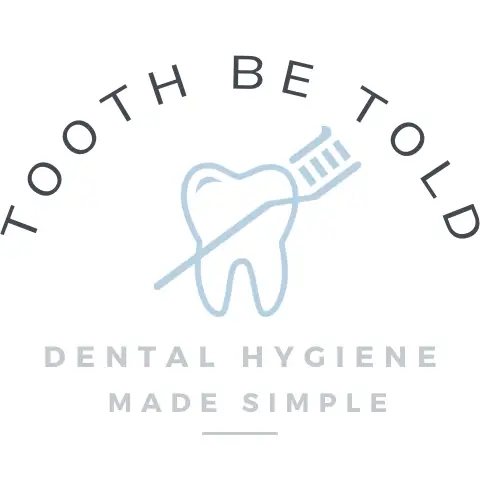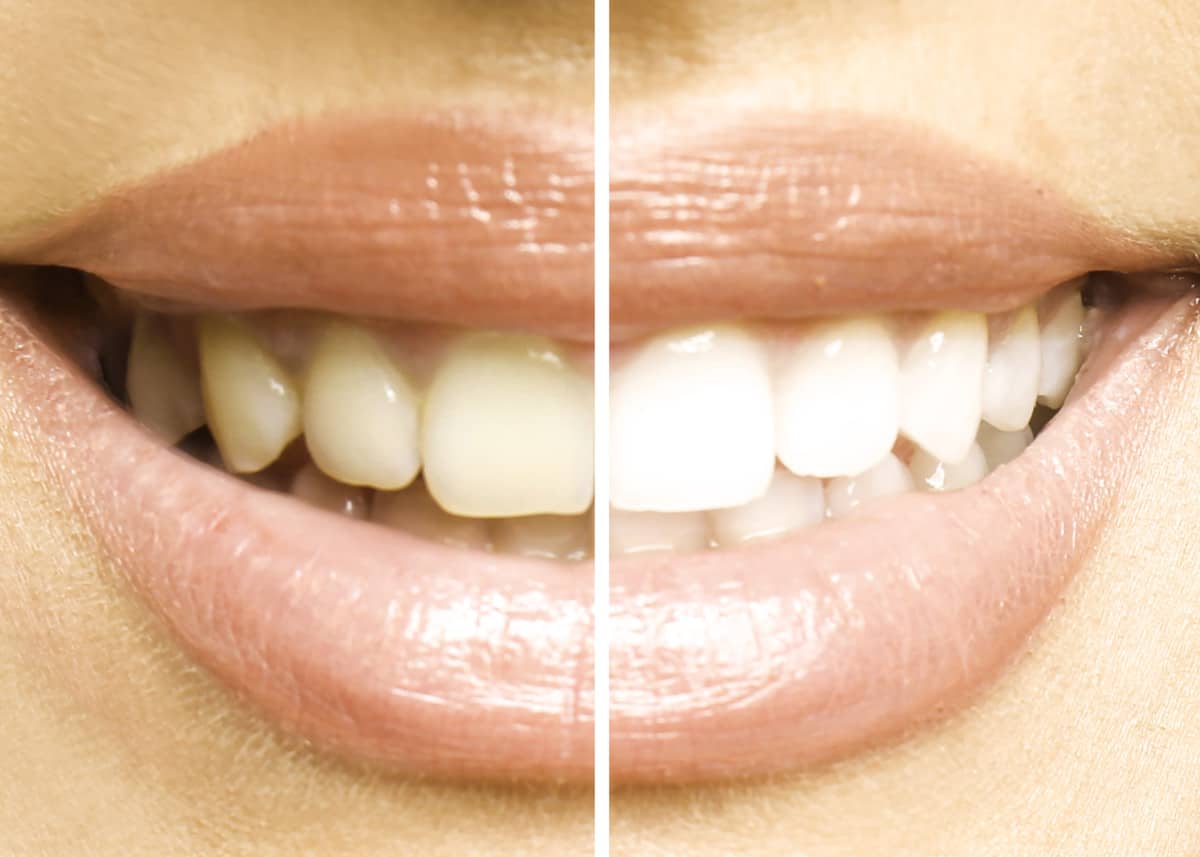
We all want that bright white smile, and even more so since Hollywood smiles are always right in front of our faces, and cosmetic dentistry has become ever more popular. But why do teeth become yellow anyways? What causes yellowing, and how do you keep those pearly whites as bright as can be?
Teeth become yellow by staining from the food and drink we consume. Also, when we eat acidic, sugary foods, use a medium-hard toothbrush and abrasive toothpaste, it will wear away the enamel, exposing the yellow-coloured dentin underneath. Calculus and plaque can make teeth appear more yellow.
The habits that are ingrained in us may be harming our teeth and making our teeth look more yellow. These habits can be hard to break, but when we can understand why they are harming our teeth, we may want to make some easy changes.
It’s important to build healthier habits and letting go of the bad habits to achieve that white smile!
Teeth can become yellow, or appear more yellow for a few more reasons than I listed above, so keep reading so you can fully understand what you can do today to make your teeth whiter and brighter!
Why teeth become yellow
Teeth can become yellow, or appear yellow. There are a few differences in how the teeth can become and appear yellow. The yellow colouring can have different shades, ranging from a darker yellow/brown colour to a more reddish-yellow colour.
The differing of yellows can come from different things that I will go over in the following subheadings. It can depend on the things we put in our mouths, but also what our dental habits are, and the makeup of our tooth structure.
Different structures of the teeth and their colour
To understand where some of the discolourations of teeth come from, we need to look at the different parts of the teeth.
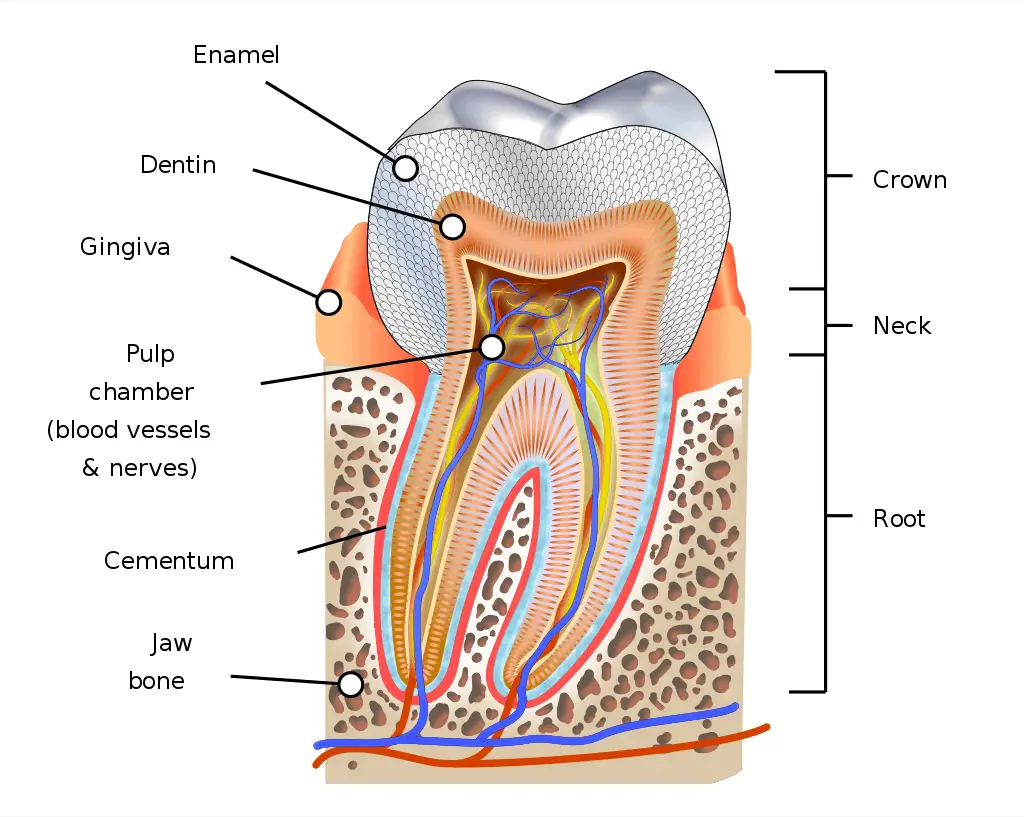
Enamel
Enamel is like the helmet of the teeth. A white helmet, gleaming in the light! It is the hardest substance in the body and protects the rest of the tooth. The enamel only covers the crown of the tooth and does not extend onto the root surface.
Cementum
Cementum is the outer layer of the root surface and is covered with bone and gum tissue when the gums have not receded. Cementum is more yellow in colour when comparing it to the enamel.
Dentin
Dentin is the layer that is right underneath the enamel and the cementum. Dentin is more yellow in colour when comparing it to the enamel.
Acid erosion
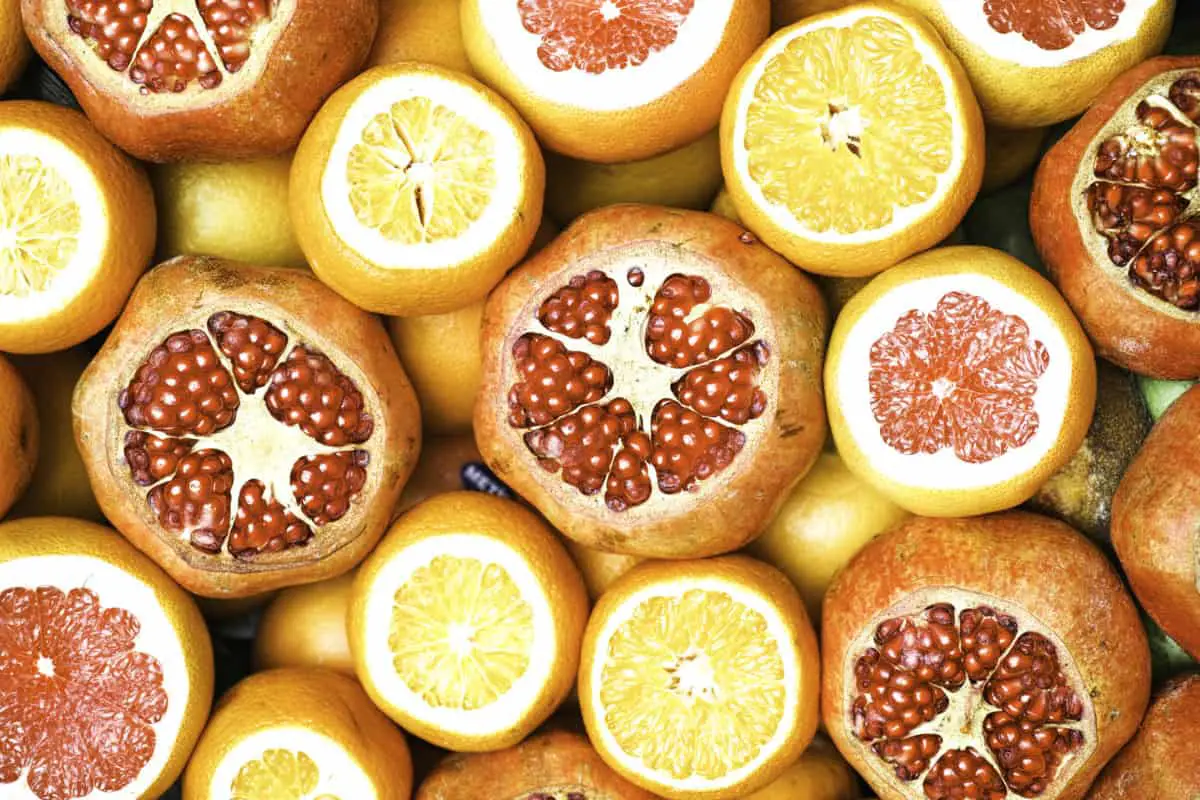
This can be from our food but also medical conditions that can cause acid reflux. It can also be exacerbated if people have a dry mouth, and the acid cannot be rinsed away by our saliva as quickly.
The bacteria in our mouths feed on the sugar that we consume and is left coating our mouths. After the bacteria consume the sugar, it produces acid that can begin to wear away and break down the teeth surface, making it more porous, but also more prone to wear and stain.
Toothbrush abrasion
Medium and hard toothbrushes are the usual suspect, along with poor brushing technique.
Some people think that the harder the toothbrush bristles, the better clean they will get. This simply is not true and can cause a lot more harm than good.
Using thinner and softer bristles will allow them to bend more and contour around the teeth, in between the teeth, and under the gums. When the bristles are too hard, they will not contour and not clean as well.
Toothpaste
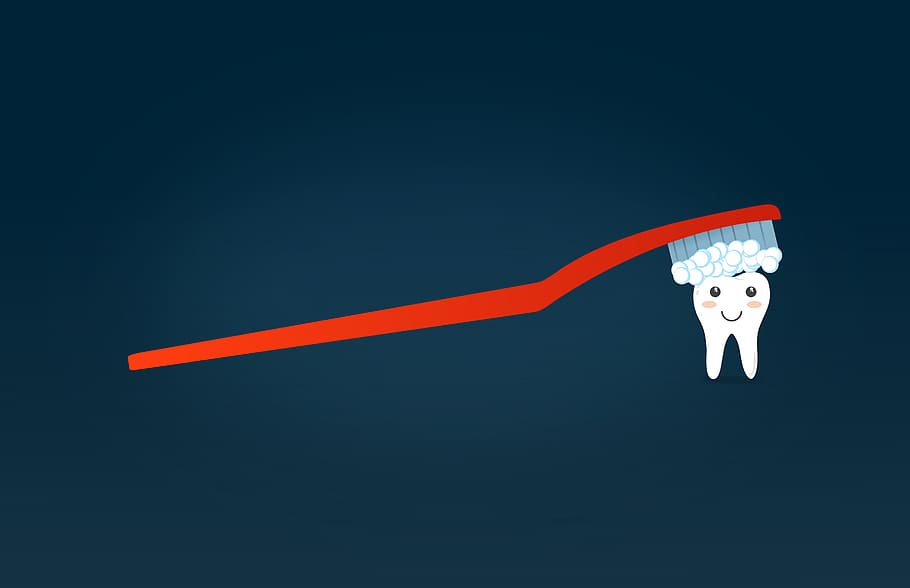
If I could scream this off a rooftop and have everyone hear me, that would be just great.
With so many companies joining the bandwagon of teeth whiting products and toothpaste and wanting a piece of the pie, we can’t get away from whitening toothpaste!
When I walk down the dental aisle at the store to pick up a tube of toothpaste, I can’t help but notice the word WHITENING on almost every tube/box.
But how do these whitening toothpastes work? They work by using abrasives in the formula, to wear away the stain on our teeth and remove the top layer of the tooth to expose more white enamel below.
I have a personal story from a patient I had at work. This patient had not come into our office for a few years. His chief complaint was that his front teeth appeared so yellow, and what could he do to make them more white.
I did my exam of the mouth, and the front teeth in particular had almost NO enamel left… what the heck!?
After asking a few questions about his oral hygiene habits, he told me that he was brushing with whitening toothpaste, and even started brushing at work at lunch to try and make his teeth whiter.
The thing was that the whitening toothpaste was so abrasive, and with his brushing with hard pressure three times a day, he wore away almost all the enamel on his front teeth.
He was so upset and angry that the whitening toothpaste did not have a warning on it to say that it is abrasive and can wear away the tooth surface.
This is why educating and informing consumers is important. If everyone had this information, most people would be avoiding whitening toothpaste. Sometimes the simpler the better, and using a basic toothpaste is the best option.
Absorption – the tooth is like a sponge
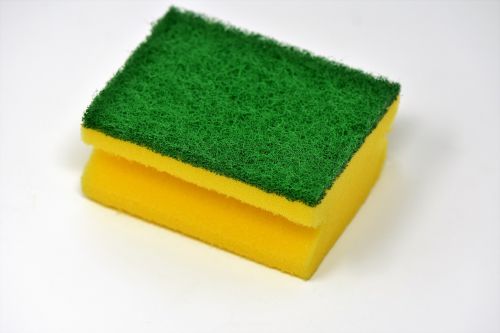
When we eat acidic and sugary foods, it breaks down the tooth surface and softens it, so it acts like a sponge.
When the teeth are in this state, anything that you consume with pigment will be absorbed into the teeth. When whitening teeth, the diet that we follow during and shortly after the whitening determines how effective the treatment is. This is something that a lot of people do not go over, or are even aware of, which is a shame.
You can read more about the impacts of diet and how it contributes to staining teeth in the article I linked below. Even if you are not whitening your teeth, it gives a much more detailed explanation of the food and drink and habits that should be avoided to keep a white and bright smile.
Read now: Teeth Whitening: Foods and Drinks to Avoid During and After
Root exposure
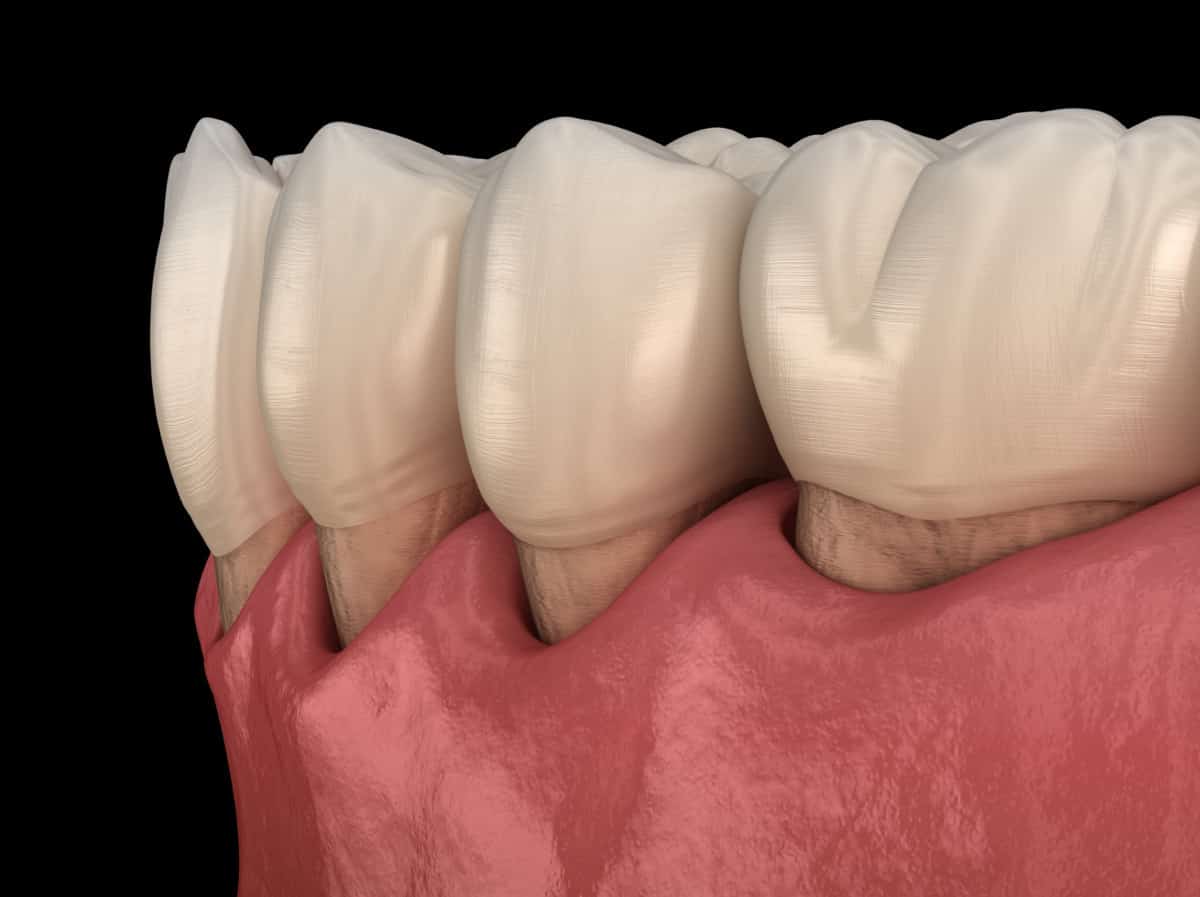
Root exposure happens when the gum recedes on the teeth. This can happen from gum disease, hard brushing, and even clenching and grinding.
The roots of the teeth are made out of a different substance than the crown of the teeth and do not have white enamel on them. The roots are made out of cementum and dentin, which are darker than enamel, having a more yellow tinge. So when you have root exposure, your smile may appear less white.
Also, the root surface is much more porous. Because of its porosity, it will absorb more stain than enamel will and lead to more staining and discolouration.
Clenching and grinding teeth (abfraction)
The way the teeth are formed and how they attach to the tooth socket makes them able to flex slightly when we are eating and add a cushion. If they didn’t have this mechanism, we would have many more cracked, chipped and broken teeth.
I always say to my patients, imagine your teeth as a trampoline, with the springs being all the fibres that hold the tooth in the socket.
Where the crown of the tooth meets the root, the hard enamel fades out to the softer root surface. So if we are putting extra force on the teeth (that comes with clenching and grinding), the teeth will flex the most where the hard enamel fades out to the softer root surface.
Over time this can cause parts of the root and crown to chip off, resulting in a notch at that junction.
Imagine when we cut a tree down with an axe. That notching can make the tree much weaker, and eventually topple over. This can happen with the teeth and can make them more prone to breaking.
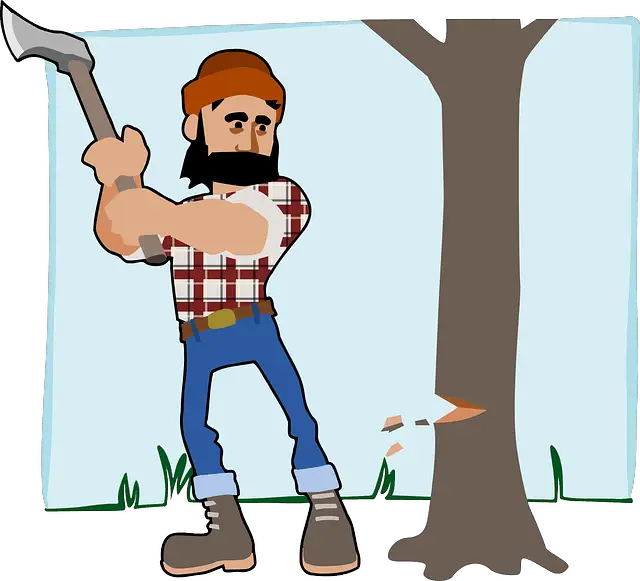
But this chipping also causes the yellow dentin to show through, making the tooth appear more yellow in that area.
Build-up on teeth (plaque and calculus)
This is probably one of the most common causes of yellowing. There are billions of bacteria in our mouth, constantly reproducing. The bacteria mostly adhere to our teeth, focusing along the gumline and in between the teeth. Dental plaque is a mixture of bacteria and food debris that can be visible on the teeth.
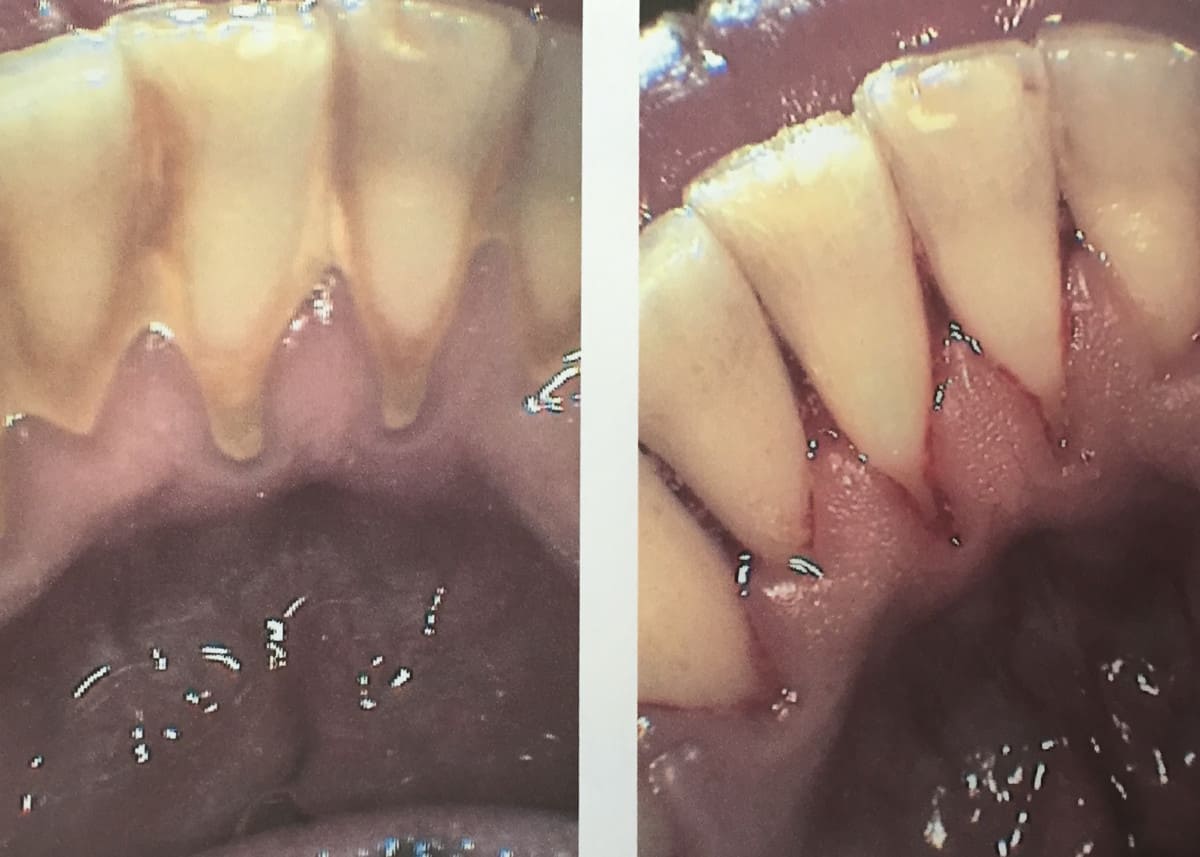
Right photo is after the dental cleaning and the white teeth are more exposed.
The plaque can absorb pigment, from the food and drink that we consume, it can be yellow, orange, or even green.
When plaque is not removed routinely from the teeth, the minerals in our saliva start to calcify the yellow plaque onto our teeth, forming calculus (also known as tartar).
Calculus cannot be removed by flossing and brushing and has to be removed by a dental professional. And over time, the calculus can absorb blood from our gums if there is active gum disease, making it darker.
Maintaining regular dental hygiene appointments to have your teeth cleaned is so important for not only maintaining oral health and overall health but keeping your teeth white!
Daily habits
Many of our vices and daily habits can cause stain on the teeth, and for some people, the stain that accumulates on their teeth is worth it, especially if they have it removed regularly by a dental professional.
The daily habits that we have that can increase staining can be found below.
Smoking (all smoking, including cigars) and non-smokable tobacco example: chewing tobacco.
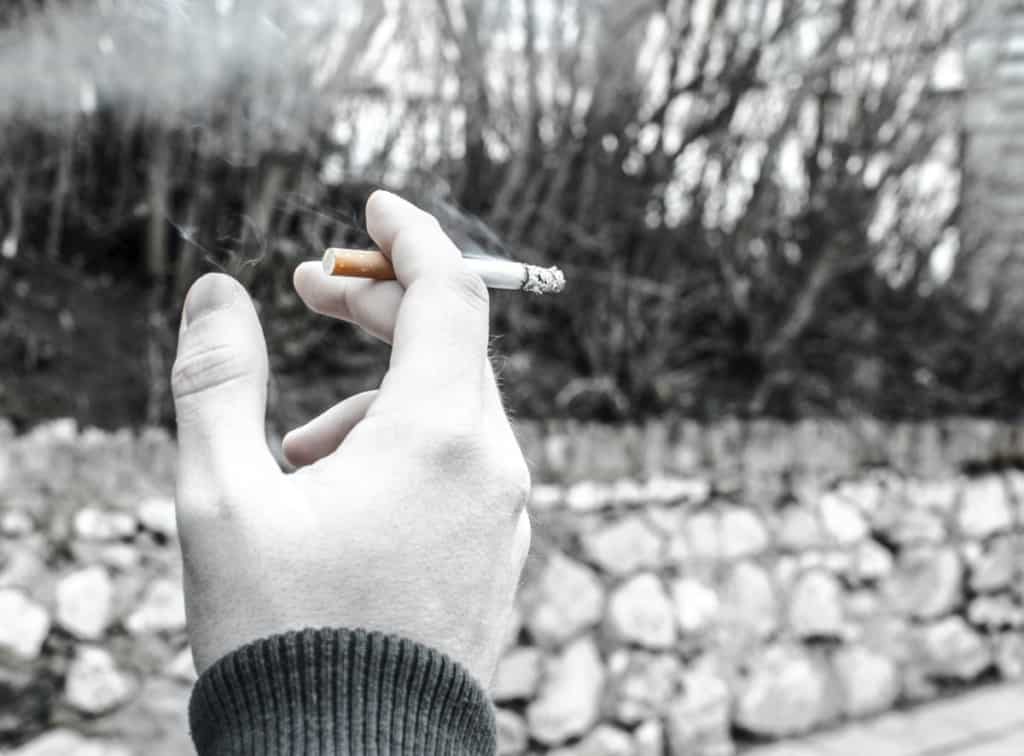
All tobacco products can stain teeth. Some quicker than others, with cigars being the worst culprit.
If you are not interested in reducing or cutting out the use of tobacco products from your daily life, there are a couple of things that can reduce the amount of stain. The biggest thing is rinsing with water after using the tobacco product.
Tobacco stain is one of the hardest stains to remove and clean off the teeth. And it doesn’t only affect the colour of the teeth, but can cause changes on the tongue and all the other soft tissues of the mouth.
Poor oral hygiene
When bacteria and food debris are not removed regularly, it can start to discolour the teeth and make them look more yellow.
The build-up on the teeth can absorb both blood from bleeding gums, and pigment from the food and drink we consume.
If gum disease is more moderate to severe, simple things like toothbrushing or eating can cause the gums to bleed. Because the build-up on the teeth is porous, it will absorb the blood, and over time start to appear darker.
Diet (acidic, sugary, and pigmented foods)
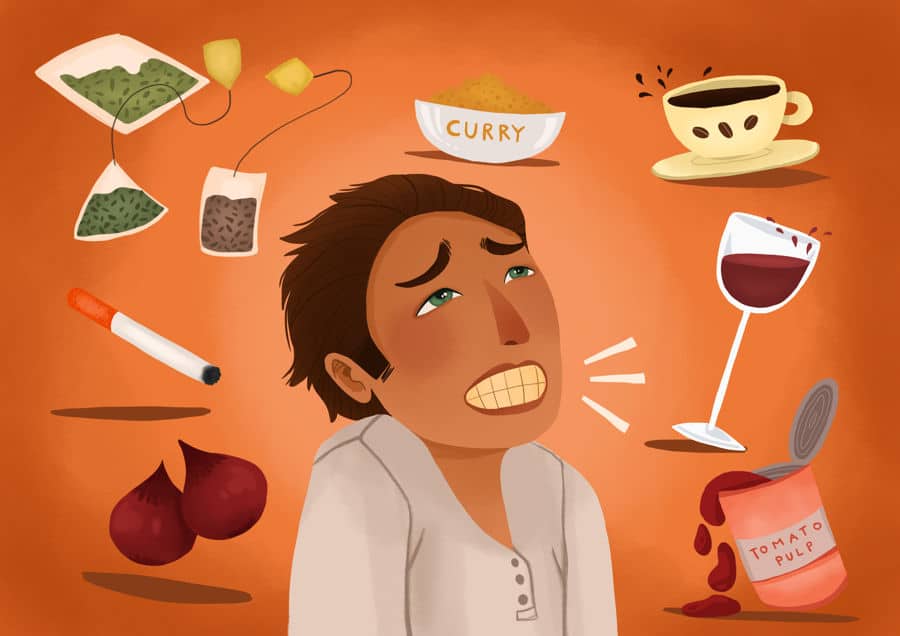
Foods with dark pigments can also be absorbed, and darken the build-up on the teeth. The build-up on the teeth happens mostly between the teeth, along the gum line, below the gums, the tongue side of the lower front teeth and the cheek sides of the top molars.
Pigmented foods are not the only culprits to stained teeth. When we consume things that are higher in acidity, the tooth structure is softened and will absorb the colour from our foods more readily, like a sponge. The pH levels of what we consume can contribute to the stain on our teeth.
pH scale
The pH of what we consume has a direct effect on our oral health. Our saliva is 6.2 to 7.6 pH, and when our mouth gets more acidic, the saliva helps to bring it back up to a safe level. When the pH of our mouth is below 5.5, that is when a cavity can begin to form, and the tooth surfaces are softened.
The pH is really important to keep in mind when we are eating and drinking. When we consume something that has a lower pH, it takes about 30 minutes for the saliva to buffer the acid out and bring the pH level back up to a safe level above 5.5 pH.
We should be concerned about and how long that our mouth is in a more acidic state. Because the longer the mouth is below the pH level of 5.5, the more damage that will occur, and more stain can accumulate on the teeth.
If you drink one glass of orange juice in 5 minutes the amount of time your mouth will be in an acidic state for far less time than if you drank the orange juice over 2 hours. Taking longer to drink it will cause more issues, increasing the chance of getting a cavity and having pigment from other things that you consume absorb into the teeth.
Dry mouth can prolong the amount of time it takes to buffer out the acid in the mouth. Both medical conditions and medications can have an impact on how much saliva we have, and how quickly it’s produced. So if we have less saliva, we are more prone to dental issues, and the stain will adhere more to the teeth.
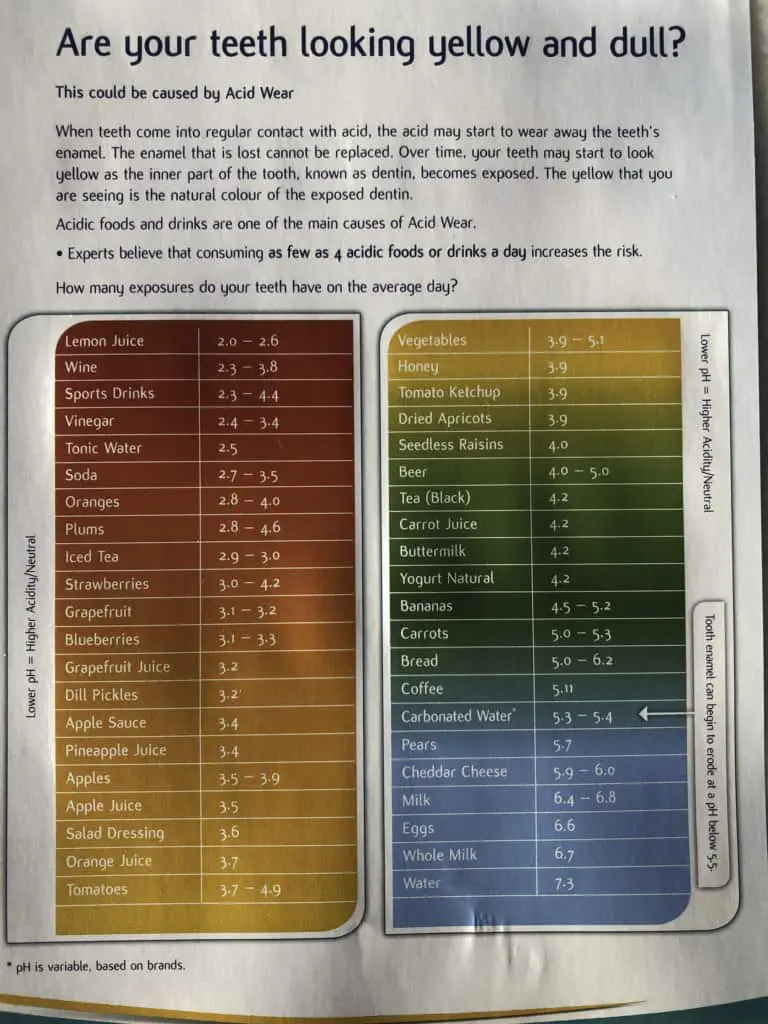
Coffee and tea consumption
Coffee and tea fall into both the categories of pH and pigment. They are more acidic and can start to soften the enamel, allowing the pigment to be absorbed into the teeth more easily.
These daily habits are some of the most commonly known culprits for staining teeth.
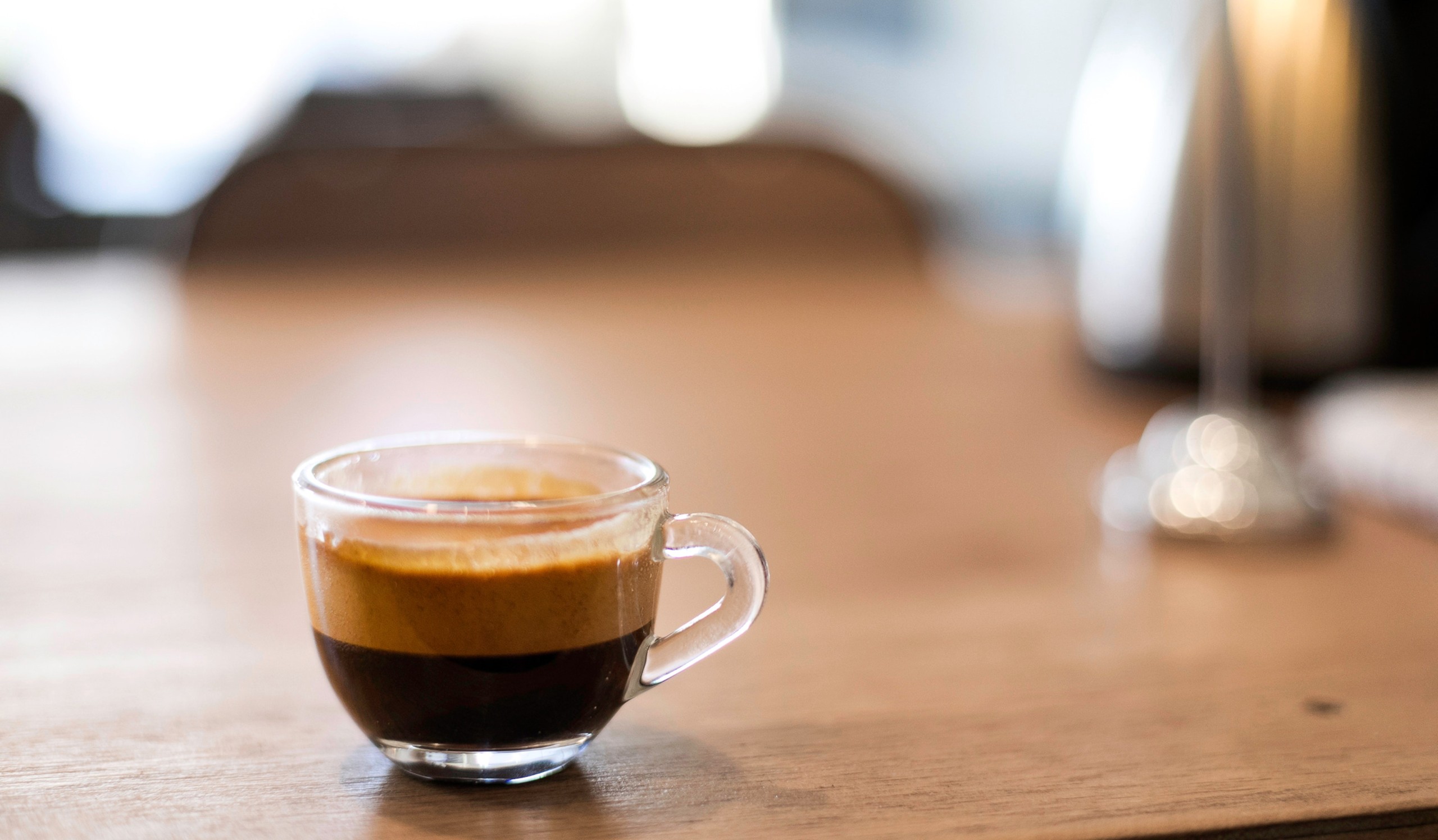
Coffee and tea are both highly pigmented, and even the lighter teas can cause stain.
When drinking coffee and tea, it is a good idea to have a glass of water along with it. So while you are drinking the coffee and tea, you can sip the water, and swish it gently around the mouth to rinse away some of the pigment, preventing it from staining the teeth.
There are 2 types of stain. Intrinsic and extrinsic.
What is intrinsic stain?
The intrinsic stain is inside the tooth and embedded within the tooth structure. It can only be removed with hydrogen and carbamide peroxide. There is no evidence that any other substance will work to whiten the tooth structure. So save your money and don’t fall for gimmicky online teeth whitening solutions.
What is extrinsic stain?
Extrinsic stain is on the outside of the tooth and is not embedded in the tooth structure. Extrinsic stain can also be in the calculus (calcified bacteria on the teeth), and it can only be removed by a dental professional, with specific tools.
It can also just be a stain that adheres to the outside of the tooth. This is what whitening toothpaste target, they are abrasive to scratch away the stain that it on the outside of the teeth and won’t actually whiten the tooth structure.
Shade guides/hues of teeth
Teeth can be all sorts of colours with different hues and brightness. There is a universal shade guide that we use in the dental setting to measure people’s teeth shade and then compare it after their whitening procedure is done.
But sometimes someones natural tooth colour is more grey, or it’s more yellow. The shade/hue of the teeth plays a large part in how effective teeth whitening can be. Yellow/brown tones tend to whiten better, with the grey tones being harder to treat and get whiter.
Often when you see the bright white smiles splashed all over social media, online, and in magazines, they are edited. It’s discouraging to see, especially because people want the whitest smile that they can achieve, and it is just not possible because the ideal they have in mind is actually fake.
Also, many of the people you see with these blinding bright white teeth have veneers/crowns on their teeth. The part of the tooth that we are looking at is not real and is fabricated out of a material that is brighter and whiter than what you could get with a natural tooth.
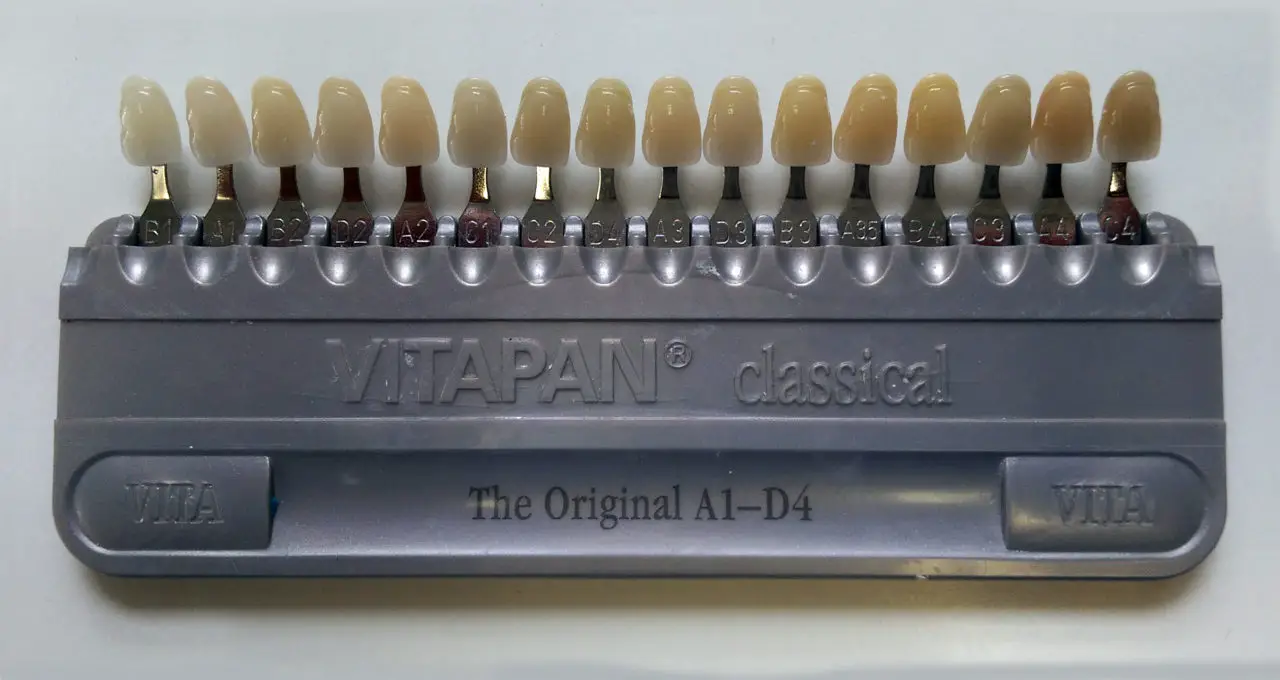
We take people’s tooth shade when they are having dental work done. Let’s say, someone is getting a crown, we want to match the shade of that crown to the teeth beside it, so the crown doesn’t stand out, and looks natural. Nobody wants a chicklet for a tooth, do they?
Particularly for the front teeth, when the crown is being made, it can be stained and painted to match the undertones and hues of the teeth beside it. This way, it can match and blend in, to look like a real tooth! Some dental work is incredible, and you can barely tell the difference between a real tooth and a fake one!
Common tips you see elsewhere on the internet that simply DO NOT WORK and the reasons why they could be making your teeth more yellow

Teeth whitening has become so popular, and everyone wants to know the cheapest way to do it! So that leaves people combing the world wide web for cheap and fast ways to whiten teeth. And with many things on the internet, these whitening tricks are not effective and potentially harmful to the teeth.
And sadly, people fall for it because the words are next to some wonderfully photoshopped picture of white teeth. And it’s no fault of the reader, how are they supposed to know what is right, and what is wrong!
Teeth can only get so white, and most of the time, when we see these white teeth, either they are fake or photoshopped.
I can’t stress enough to my patients to stay away from at-home whitening solutions that can harm their teeth and actually make them more yellow!
Below you can find the most common tips and tricks that you can find on the internet that should be avoided!
Oil pulling
Dental oil pulling usually is done with coconut oil. Oil pulling does have it’s benefits, but it is not going to whiten your teeth. By flossing, brushing and then adding in oil pulling, you may get some benefit. But the scientific evidence just isn’t there.
However, I have had patients oil pull, and they like how it makes their mouth feel, and also helps with a dry mouth! I have nothing against oil pulling, and I do believe it has its benefits, but it just won’t whiten your teeth.
Lemon and Baking soda

PLEASE NEVER DO THIS! Some famous doctor who has a tv show, I’m sure you can figure out who, came out and said that you can make a mixture of lemon juice and baking soda to whiten teeth. The instructions said to leave it on the teeth for a certain amount of time, then brush it off.
For the love of anything, I beg, please do not do this. I sound like a broken record, I know.
Using anything acidic as an aid for whitening teeth will just dissolve your tooth surface. A surface, that unfortunately once it’s gone, it’s gone.
Hydrogen peroxide
This will whiten your teeth, but not a lot, and could damage your teeth in the long run. The percentage would be so low, and the result would not have a sufficient difference to when you first began.
Also, while using this product, your teeth will be more susceptible to absorbing pigments from our food and drink. So you don’t want to use this for too long.
Charcoal
The trend in the last few years is charcoal, we see it everywhere. It seems as though even the big brand names have gotten on the bandwagon. The big brand names want to make money off of trendy items that people are more willing to buy. It’s mostly about money.
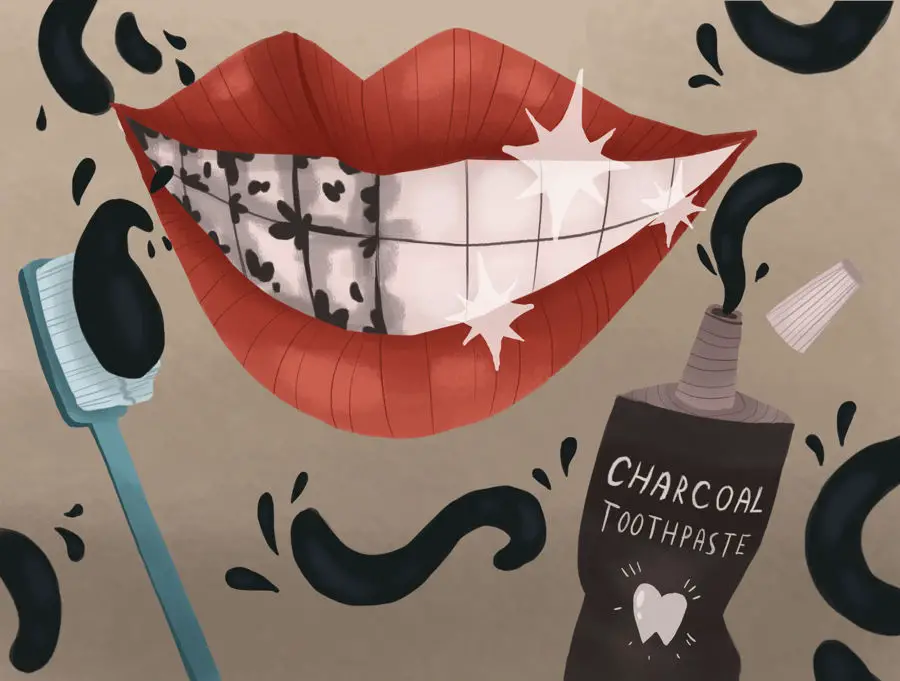
Charcoal is abrasive, however, it is one of the least abrasive out of the whitening toothpaste options. The advice I give to patients is, once in a while is okay, maybe once a year, to use it for a couple of weeks.
However, they need to be very careful with it, always using an extra soft or soft toothbrush, and do not brush too hard. Also, always wait for at least 30- minutes after eating or drinking because the tooth surface is softer, and brushing with an abrasive will take off even more tooth structure that we can never get back.
Whitening toothpastes
This is similar to charcoal but can be much more abrasive and cause damage to the teeth and gums. The only time I EVER recommend a whitening toothpaste to a patient is when they have an excess amount of extrinsic stain. I only recommend that they should use it for a short time, maybe 2 weeks, then stop and go back to another non-abrasive toothpaste.
Banana peel
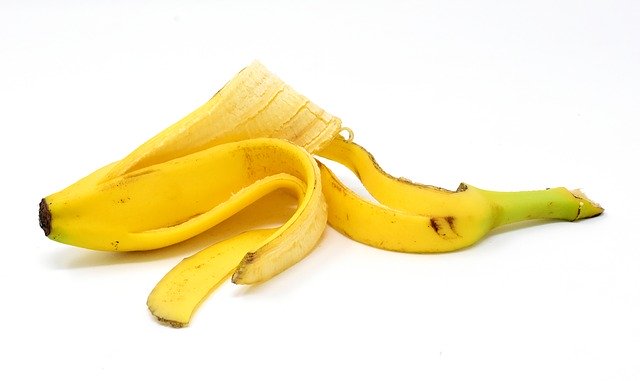
I have actually tried this one myself. I had a very good professor when I was in dental hygiene school, and for one class, all we did that day was try internet tricks for whitening teeth.
This one works by rubbing the banana peel on your teeth. This does not work. The only this it does it put a whiteish mush on your teeth to make your teeth look more white, gross!
This can be problematic because there is sugar in the banana peel, and it will encourage bacterial growth and an acidic environment that can contribute to staining and cavities.
How to prevent stained teeth in the first place, before the stain even happens!
Preventing stain in the first place is the best solution. And it is also the cheapest method to a white, bright and healthy smile.
I wrote a whole post on how to prevent stained teeth. I know it can focus on coffee stains, but some points will be relevant to everyday life, regardless if you drink coffee or not.
Read now: Snub Coffee Stains; Dental Hygienist’s Guide to White Teeth
How to make your teeth appear more white.
This comes down to contrast. If you wear a darker lipstick, it can make your teeth appear more white. A bold red lipstick will help your teeth appear more white! 🙂
How to ACTUALLY whiten your teeth
I always want my patients to whiten their teeth safely if they are going to do it. And I think for a lot of people, they are asking their dental professional about certain products on the market, and if they are safe and effective to use.
Whitening the actual tooth structure needs to be done chemically. The best way to do it is the in-office whitening at your dental office. Although, if you are looking for a new dentist, some will offer complimentary whitening when you start as a new patient. So keep an eye out!
Teeth whitening can be a tricky process, with a lot of the process explaining the dos and don’ts before, during and after the whitening treatment. And the way you whiten can determine how good your results will be, with doing the least amount of damage!
I wrote a whole post on in-office whitening treatments vs over the counter treatments that you can find linked below.
Read now: Teeth Whitening: Why It’s Worth Having Done at the Dentist
If dental office whitening is not an option, then the next best thing is to use Crest Whitestrips, the ones that I recommend can be found on my whitening resource page .
.
You want to stay away from abrasive whitening toothpaste and gimmicky whitening products that are being sold that have no scientific research on if they actually work or not.
FLOSS
Here comes the most famous F-word in my vocabulary… FLOSS. Floss, floss, floss.
I know it’s the never-ending preaching from us dental people that flossing is important for your oral health. But it can also make your teeth more white.
Removing the plaque from in between the teeth (where the toothbrush can’t reach) before it can take on the colour of the food and drink you consume. The longer the plaque is left on the teeth, the more pigment it will absorb, and the more it will calcify onto the teeth, which cannot be removed with flossing and brushing.
And don’t forget to brush 2 x a day 🙂
I really hope this post has helped you to acheive a white, bright and healthy smile!
Holly 🙂
